Rutabaga is a very popular vegetable in Ireland, but the name is never used by the Irish to describe this favorite side for a chicken roast, ham or bacon dinner.
In Ireland, this favorite Thanksgiving vegetable is called a turnip.
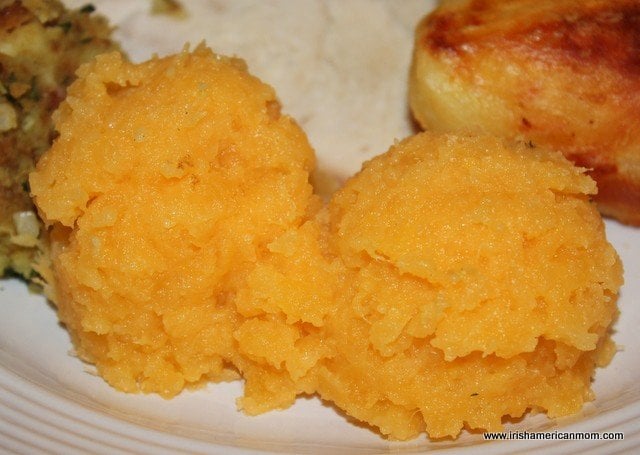
Table of Contents
- Why Do The Irish Call A Rutabaga A Turnip?
- Rutabagas for Thanksgiving
- Purchasing Rutabaga in America
- How To Peel and Prepare A Rutabaga, Swede or Irish Turnip for Cooking
- Ingredients for Irish Style Mashed Rutabaga
- Directions for Cooking A Turnip Irish Style
- What to Serve with Mashed Rutabaga
- Video for Mashed Yellow Turnip
- Recipe Card for Mashed Rutabaga
Why Do The Irish Call A Rutabaga A Turnip?
The Irish call this root vegetable a turnip. Why exactly is not clear.
The English call it a swede, and in Scotland it is often called a neep.
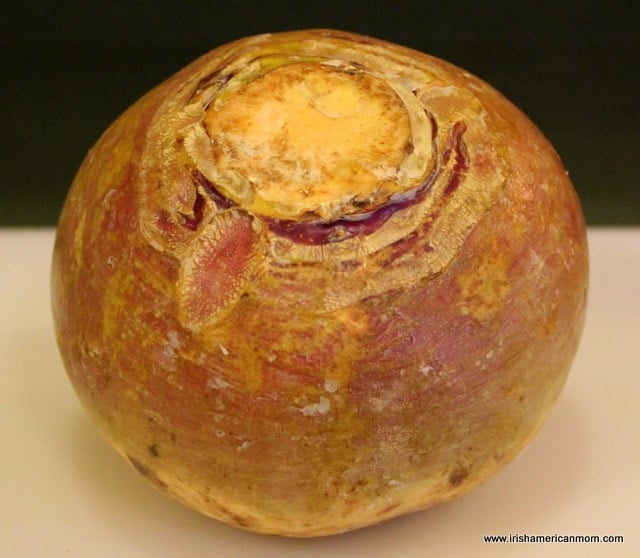
The term rutabaga comes from the Swedish word "rotabagge".
It is a bulbous root vegetable with a purple hued outer skin covering a dense inner yellow core.
In France the humble rutabaga is not considered fit for human consumption and is reserved for animal feed. However, it is used extensively in Ireland, the United Kingdom, Scandinavia and Russia as a side dish or as an ingredient for soups and stews.
American rutabagas, Irish yellow turnips and British swedes, and Swedish turnips all belong to the Brassica napobrassica family of plants. You'll often hear they're members of the brassica family.
Yellow turnip is the same vegetable as a rutabaga.
Now small little white turnips are technically called Brassica rapa. These smaller, white fleshed roots are very popular in southern American cooking, and provide us with that ever so southern staple, their famous turnip greens made with turnip leaves. Rutabaga is different to white turnip.
White turnips are less bitter than the yellow variety. White turnips can be eaten raw and are a nice addition to salads.
Another difference between rutabagas and small turnips lies in their leaves. Turnip leaves are a light green color and they tend to be thin and slightly hairy. In contrast, the rutabaga leaves are thick and smooth and are a bluish-green color.
American rutabaga and Irish turnips have a dense, hard yellow flesh, while small American turnips have white flesh.
Rutabagas for Thanksgiving
My thoughts turn to rutabagas with Thanksgiving approaching. I know it's not a traditional vegetable for Americans to serve, but a turnip tale links it to this holiday for me.
When I was close to seven months pregnant with triplets, my aunt visited for Thanksgiving. She was born in Ireland, but has lived in America for over fifty years. She suggested we have Irish mashed turnips with our turkey that year, since serving rutabaga at Thanksgiving had become a personal tradition for her over the years.
Despite resembling a moving mountain at this point in my pregnancy, I dutifully waddled to the grocery store, plonked my colossal self into a motorized cart, and sped through the vegetable aisles, never dreaming there might be a shortage of rutabagas. Lo and behold there wasn't a single rutabaga to be had.
"We always run out of rutabagas at Thanksgiving," the produce manager explained. "It's the one time of year they are in demand."
I returned home shocked and empty-handed.
But never fear!
Irish American Dad fancied a scoop of mashed turnip instead of an overly-sweet, sweet potato casserole that year. He rose to the challenge, searching high and low, from grocery store to fresh fruit market, along the turnip trail.
He did not fail us. He found one hiding beneath a head of cabbage in a Meijers store far, far away. And so that year we gave thanks, for one man's perseverance in his quest to deliver a Thanksgiving rutabaga.
And being an Irish man, he knew exactly what he was looking for, once we told him he was on a quest for a good, old Irish turnip.
Purchasing Rutabaga in America
Practically every time I buy a rutabaga at the grocery store, the check-out guy or gal holds it up with a quizzical expression.
"What's this called," comes the inevitable question.
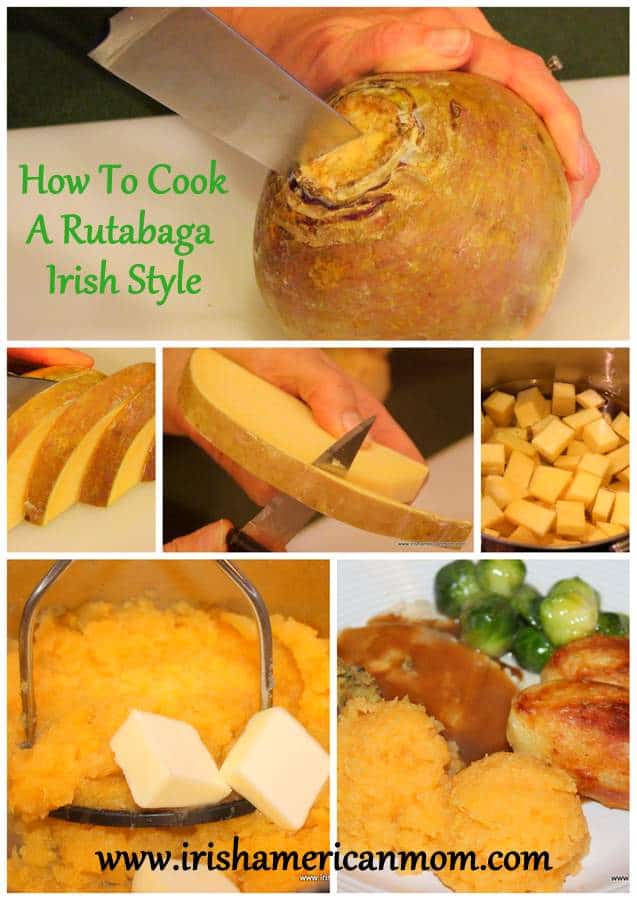
I think very few Americans buy rutabagas, probably because they simply don't know how to cook them.
So be prepared to advise the checkout person that the vegetable they are weighing and scanning is a rutabaga.
However, things are beginning to change in the American rutabaga world. They're becoming a staple in the Keto loving community, with many Keto lovers using them as a replacement for potatoes.
There are many ways to cook turnips or rutabagas. They're delicious in soups and many people love to roast them. I make a delicious carrot and rutabaga soup which you might enjoy.
But no matter which recipe you choose, the first step to cooking with rutabaga, involves peeling it.
How To Peel and Prepare A Rutabaga, Swede or Irish Turnip for Cooking
Today I will solve that problem of how to prepare a rutabaga for cooking, with a short synopsis of my more in-depth tutorial on how to peel and cut a rutabaga.

The most difficult and dangerous part of this process is cutting up the rutabaga.
When picking one in the grocery store, I try to find one with a flat bottom end. It makes it much easier to balance to make that first cut through the hard inner core.
Place the root on a cutting board, balanced on its flattest end. Cut through the middle separating it into two equal halves.
Perform this step with care.
Some people like to microwave the rutabaga before peeling it to make the whole process easier.
I personally don't microwave my rutabaga before peeling, but I have years of rutabaga cutting experience under my belt. What a claim to fame!
If you would like to soften your rutabaga in the microwave to make it easier to peel, then follow these steps.
- Prick the rutabaga skin in several places with a skewer.
- Wrap it in damp paper towels and place it in a microwavable dish.
- Cook it on the high microwave setting for 5 minutes.
- Then turn it upside down and repeat for another 5 minutes.
- Remove it from the microwave and allow it to cool before slicing it in half as directed above.
- You are now ready to move on with the next steps outlined below.
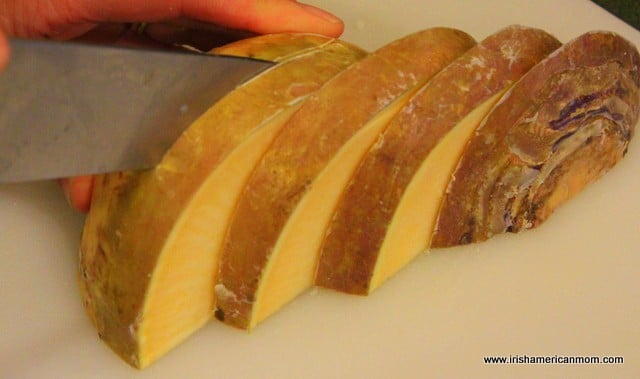
Turn each half onto its flat side, then cut it into ½ inch thick semi-circles.
Throw away the first and last piece which are covered in thicker skin.

Use a paring knife to remove the outer skin.
This method is much easier than trying to peel a rutabaga with a potato or vegetable peeler - really a mission impossible.
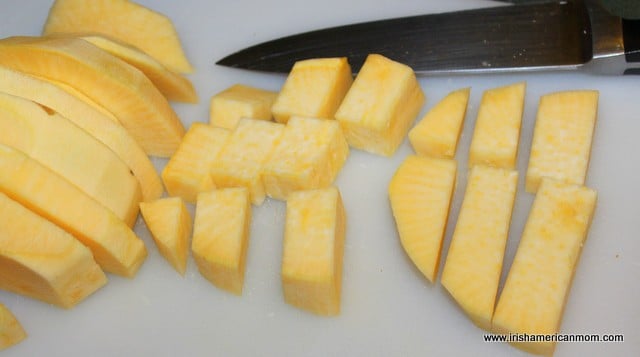
Next cut each piece into one inch cubes. Each semi-circle usually yields nine cubes by cutting 3 vertical slices and then three more perpendicular slices.
Now you're ready to cook your rutabaga.
Today we're going to be boiling our turnip or rutabaga using the tried and trusted cooking method of most Irish cooks.
So enough of my waffling, let's get down to cooking this tough little root. Here's my traditional recipe, handed down from my mother, and her mother before her.
Ingredients for Irish Style Mashed Rutabaga
Here you’ll find a quick list of what you’ll need for this recipe. Check out the printable recipe at the bottom of this post for US and Metric equivalent versions of the recipe. There you can choose the measurement system that works best for you.
Here's what you'll need:
- rutabaga
- butter
- salt
- white pepper
- sour cream (optional)
- light brown sugar (optional)
Ingredient Tips and Substitutions
You might like to add a little chopped up bacon to the water you use to boil the rutabaga. It imparts lots of flavor to the final product.
Another option is to add a little bacon grease instead of the sour cream when mashing your rutabagas.
Sour cream is an optional ingredient. Irish people usually only add butter and mash away.
Also, a touch of brown sugar adds a lovely sweet hint to the finished product. This is an Irish American cooking tip. Other options are to add a dash of honey or maple syrup.
Some people like to add some minced garlic or a clove or two of garlic to the pot as the rutabaga simmers. This adds extra layers of flavor. A sprig or two of thyme is also another flavorful addition to the boiling water, but remove the sprigs once the rutabaga is cooked.
Directions for Cooking A Turnip Irish Style
Here you’ll find step-by-step photographic instructions to help you recreate this recipe successfully.
There are plenty of tips included along the way.

Cook by simmering
Peel and cube the rutabaga.
Add the diced rutabaga to a medium saucepan and cover it with cold water.
Some of the pieces will float in the water making it impossible to cover the top by an inch.
Season with salt at this point.
Make sure you add plenty of water though. If the pot boils dry the smell of burnt rutabaga is horrible. Believe me - I know from experience.
Bring the water to a boil, then lower the heat and simmer for 40 to 50 minutes until the rutabaga is fork tender.
It takes quite a long time to boil this tough little vegetable.
If you microwaved your rutabaga when peeling it, the cooking time will be a little shorter.

Mashing boiled rutabaga
Drain the boiling water once the rutabaga is cooked. Return it to the pot.
Use a potato masher to break it up. Add 2 tablespoons of butter. Season with salt and white pepper.
Most Irish people use white pepper since we don't like black flecks through mashed turnip.
Mash the rutabaga well together to make sure the melted butter is thoroughly mixed through.
Add the sour cream, if using, and mix through the rutabaga mash.
If you wish to limit how much butter you use, you can omit butter and increase the amount of sour cream used instead of using butter.

In Ireland we mash our yellow turnip with a potato masher. If you prefer a smooth purée with no texture, then you can use an immersion blender to blitz the cooked and drained rutabaga. Alternatively you can purée it in batches in a food processor or blender.
Sweetening mashed rutabaga or turnip
Sour cream flavor compliments the sweet yet tangy taste of the rutabagas. Some people like to purée the rutabaga in a food processor, but I prefer to leave a little bit of texture by using a potato masher.
Another tip to sweeten the rutabaga is to add a few teaspoons of brown sugar at this stage. It adds an extra layer of deliciousness.
I didn't grow up eating brown sugar sweetened turnips so I'm going to make this step optional.

What to Serve with Mashed Rutabaga
Served hot, as a side for roast turkey dinner, mashed rutabagas are simply delicious. It truly is an Irish American favorite side dish for Thanksgiving.
Other dishes that are extra delicious with mashed rutabaga include:
- boiled pork with sauerkraut as a side
- pork chops
- boiled bacon
- ham steaks
- roast lamb
- roast chicken
Irish people love to serve rutabaga with mashed potatoes. They're delicious with Irish style fluffy mashed potatoes, which are made with floury potatoes and are less creamy than American style mash.
And for special dinners like Christmas and Thanksgiving we love to serve roast potatoes, with our turnips or rutabagas.
I love two nice, big mounds of rutabaga mash on my plate. Once I dined at a fancy restaurant in New Jersey.
I grew excited when I saw a pork dish on the menu with a side of rutabaga puree. Oh how disappointed I was when all I got was a yellow squiggle of rutabaga on my plate. It didn't fill a hole in my tooth.
So heap those rutabagas onto your plate. Not only do they taste great, they're good for you too.
Video for Mashed Yellow Turnip
Recipe Card for Mashed Rutabaga
Here's the printable recipe. Please feel free to save and print this recipe for your kitchen files. You'll find nutrition information with calories and dietary fiber information in the card below. Rutabagas are a good source of nutrients and antioxidants.
Mashed Rutabaga
Ingredients
- 1 medium rutabaga peeled and cut into 1 inch cubes
- 2 tablespoons butter
- 2 tablespoons sour cream optional
- 2 teaspoons light brown sugar optional
- ½ teaspoon salt
- ½ teaspoon white pepper optional
Instructions
- Peel and cube the rutabaga. Add the diced rutabaga to a medium saucepan and cover it with cold water.
- Bring the water to a boil, then lower the heat and simmer for 40 to 50 minutes until the rutabaga is fork tender.
- Drain the boiling water once the rutabaga is cooked. Return it to the pot. Use a potato masher to break it up. Add 2 tablespoons of butter. Season with salt and white pepper and mash again.
- Add the sour cream, if using, and mix through the rutabaga mash.
- Add the brown sugar, if using, and mix through the rutabaga mash.
- Serve hot as a vegetable side dish for dinner.
Nutrition Information is estimated based on the ingredients and cooking instructions as described in each recipe and is intended to be used for informational purposes only. Please note that nutrition details may vary based on methods of preparation, origin and freshness of ingredients used.
Rutabags or Irish turnips may not be on everyone's menu, nor be to everyone’s taste. They probably fall firmly into either the 'totally love it' or 'completely hate it' category for nearly everyone.
Nevertheles, judging by all the wonderful comments on this blog post, readers around this little corner of the world wide web, definitely place it in the 'love it' category.
Here are some other Irish style side dishes you might like to try for Thanksgiving dinner.
Maple Bacon Skillet Brussels Sprouts
Creamy Oven Baked Onions Irish Style
Happy Thanksgiving cooking to all, and thanks for following my recipes and ramblings.

Slán agus beannacht,
(Goodbye and blessings)
Mairéad -Irish American Mom
Pronunciation - slawn ah-gus ban-ock-th
Mairéad - rhymes with parade
Here are some more recipes and ramblings you might enjoy...
Irish Side Dishes
- Oven Roasted Tomatoes
- Sautéed to Perfection: Unlocking the Secrets of Flavorful Onions
- Potato Salad With Apple and Celery
- Buttered Baby Carrots
Christmas Recipes
- How To Roast Potatoes Irish Or English Style
- How To Steam A Christmas or Plum Pudding In A Crockpot.
- Homemade Mincemeat
- Chicken and Mushroom Vol-Au-Vents
Holidays
- Cardboard Tube Paper Plate Christmas Wreath
- Homemade Knotted Bow Cinnamon Stick Christmas Tree
- Irish Holidays You Should Know About
- Old Fashioned Easter Biscuits









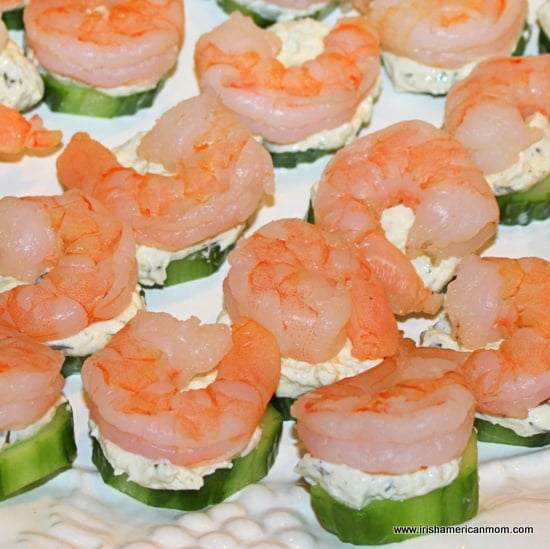

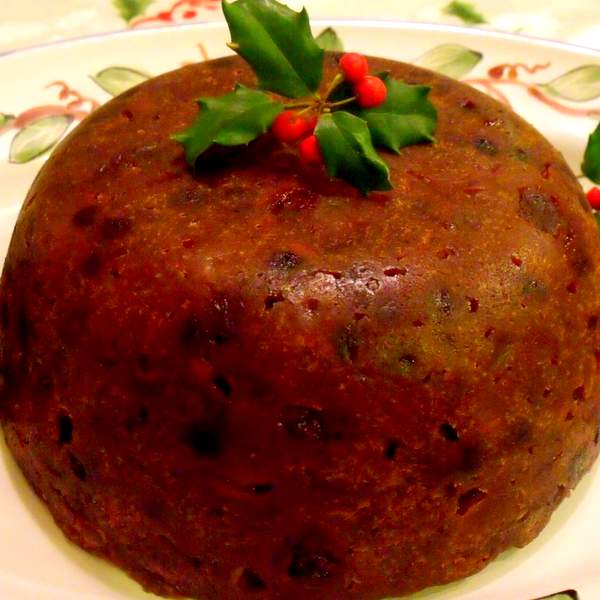





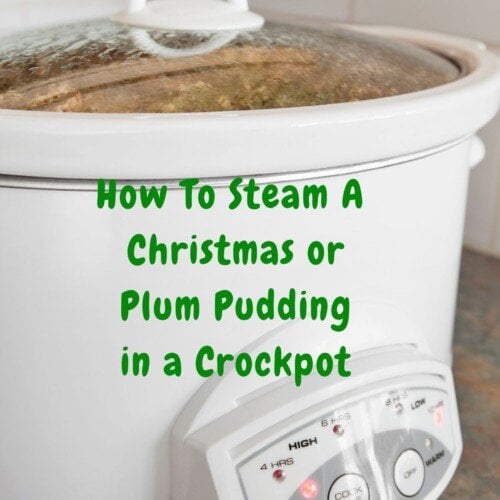

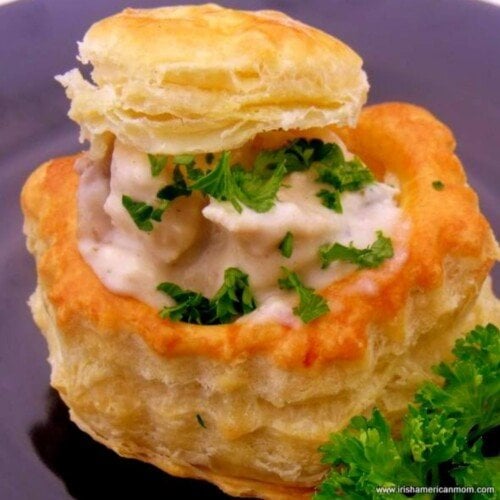







jedi1111
We eat leftover rutabaga for a couple of days after Thanksgiving. It re-heats fine. It can get a little watery, so you just have to stir it up well. To help with the prep, I peel and dice the day before and put it in a big ziplock bag. That way, Thanksgiving day, all you have to do is pour it in a pot of water.
Colleen Lowry
Thank you so much for the tip! That is what I will do this year! I must say, leftover turnips are a non existant thing in my family! There are never any left!
jedi1111
The only reason we have any left is because I make a ton of them!
Beverly
I live in Miami, FL and we love rudabagas I cook them quite often and always season them with some fresh pigtails, i decided to make some this thanksgivings for my granddaughter (6yrs old) and father-in-law (88 yrs old) he loves them also.
I've never had them mashed but will try that the next time.
Irish American Mom
Hi Beverly - Mashed turnip or rutabaga seems to be a very Irish way of preparing this wonderful winter vegetable. I sometimes roast them with other root veggies, but most of the time I boil and mash them just like my mother and grandmother did before me. Glad to hear your family love this humble vegetable too.
Best wishes, and have a lovely Thanksgiving in Florida.
Mairéad
Vera Walker (I'm Irish - English)
I would have them a little more often if I could peel them. Your hints are very helpful. Mama peeled them like an apple. I still have a question. How do I get the wax off? Or do I cut the baga in 1/2 and in slices and peel the wax off with the skin?
We cook a piece of boneless pork w/salt added until tender. Then put the chopped up bagas in the pork water until tender. Drain & mash. Serve with sliced pieces of pork. If any remains, I freeze them for about a month.
Irish American Mom
Hi Vera - Your tips for cooking turnips with a piece of boneless pork are great - sounds very tasty.
Best wishes,
Mairéad
Bruce
Don't worry about the wax. Cut the R in half, any direction. Each half flat side down, cut in slices: thinner makes easier to peel, but more slices is more work. Using a sharp short knife, slide it around the R under the peel. You want to get the white layer as well as the purple layer and wax all off at once.
Irish American Mom
Great tips, Bruce. Thanks for letting people know how important it is to remove the white layer beneath the purple skin.
All the best,
Mairéad
Annie
I'm of Irish descent and we've always had turnip for Thanksgiving or whenever we had turkey. I remember when I was little I didn't like them at all, I'd fill my plate with Butternut Squash though lol. I couldn't understand how my Mom could have so much turnip on her plate. Now I know! I love it now. My Mom told me of her little secret of putting a pinch or two of sugar in the pot while mashing them if they're too bitter tasting. I also add turnip to my beef stew. 😉
Irish American Mom
Hi Annie - It's lovely to hear from so many Irish people who love turnip at Thanksgiving, and all year round. I understand how you grew fond of turnips with the passing years. Parsnips were a vegetable I detested as a child, but love to eat them now. I suppose our taste buds change with time. Thanks for your great turnip tip for beef stew. I sometimes toss in diced turnip when I make my "farmhouse stew". I must share that recipe soon.
Best wishes and have a lovely Thanksgiving.
Mairéad
Loretta
My mother was born in Ireland and always served "turnips" at our American Thanksgiving meal. She passed in December of 2013, but I continue the tradition. I never liked them growing up, but now I can't get enough! Happy Thanksgiving. 🙂
Irish American Mom
Hi Loretta - I'm so sorry to hear of your mother's passing in 2013. I'm glad to hear you continue your family's Thanksgiving turnip tradition. They seem to be a taste that grows on us with age, especially when they are associated with such loving memories.
Best wishes, and enjoy your Thanksgiving holiday.
Mairéad
Loretta
Thanks, Mairead!
Sue
Mairead, I commented a year or two ago. I love rutabaga at Thanksgiving. My mom always made it, so now I carry on the tradition. I have a question for you. Would it be ok to peel, cube, boil and mash it on Weds, then reheat it in the oven on Thursday to serve it?
Or, can I at least peel it and cube it on Weds, put it in a ziplock bag, then boil and mash it on Thursday to serve it? I'm trying to not have to do all my cooking on Thursday.
Thanks.
Irish American Mom
Hi Sue - I often make rutabaga in advance. I sometimes make a big batch on a Sunday and we eat it throughout the week. I reheat it in the microwave, but I usually reheat it in portion sizes by this method. It can get a little watery with time and with microwave reheating. For reheating on Thanksgiving Day I would put it in a casserole and reheat it in the oven. Add extra butter knobs on top since the upper layer can get a little dry in the oven. I enjoy rutabaga best when freshly mashed. You can definitely prepare it in advance and store it in the fridge. I keep my cubed uncooked turnip in water in an airtight container.
Have a lovely Thanksgiving.
All the best,
Mairéad
Sue
Thanks so much. Happy Thanksgiving!
Gina
When I cook rutabaga, I put sugar in the water, same amount as salt. It reduces the boiling time. 😉
All the best
Gina
Irish American Mom
Hi Gina - Adding sugar is a great tip, especially if it cuts down on boiling time.
Best wishes,
Mairéad
Chris
I'm 49 yrs old and have always loved these. Even though I only eat them in the fall and thanksgiving. This is exactly how I have always made them and they are delicious. I'm from Connecticut and your right about not many people knowing what these are. It's to bad cause they don't know what they're missing!!!
Chris Maher
Thanks for this post! Growing up we always ate turnips with our Thanksgiving and Christmas meals. When I had a family I missed the tradition and tried to revive it one year, not knowing that what I craved was actually rutabaga. I mashed up turnips and they were terrible! Fortunately I figured it out and the tradition continues another generation. Happy Thanksgiving!
Irish American Mom
Hi Chris - I'm so glad you rediscovered the rutabaga and have been able to continue your family's Thanksgiving Turnip Tradition. The confusion arises when we Irish call the rutabaga a turnip. Happy Thanksgiving to you and yours.
All the best,
Mairéad
anne egan
Hi American Irish Mom from an Irish Mom....Today for the first time I heard of Rutabaga....im excited as now instead of common turnips my family will be served rutabaga. we eat turnips all the time. cubed, mashed,roasted. As children we used them at halloween hollowed out and candles inserted and of course the were chief fodder for out cows. I often pulped them before going to school. now that I know what Rutabaga is tge common turnip will never feel common again. Nollag Shona Dhuit. ( Happy Christmas)
Irish American Mom
Hi Anne - A good "feed of rutabagas" does sound more intriguing than a "feed of turnips". I grew up eating turnips in Dublin. I loved them mashed into my potatoes with a big knob of melting butter. It's funny how so many people cook rutabaga to accompany their turkey at Thanksgiving in America, whereas in Ireland we think of the good old turnip as an everyday veg, rather than a special occasion dinner treat.
So glad you found my blog and checked out my recipes and ramblings.
All the best,
Mairéad
Judi Sweat
I have an Irish daughter in law and when I asked her if she liked turnips, she replied Yes!! Well I cooked her our American version of turnips and when she tasted it she graciously remarked, "this isn't like our Irish turnips". When I did some investigating, I learned that what we call rutabaga, the Irish call turnip. Now I know and truly appreciate the big difference. I have learned to cook rutabaga and we love it! Thanks for the great description of how to best deal with the tough skinned treasure!
Irish American Mom
Hi Judi I'm delighted to hear you have mastered the art of cooking rutabaga. It's a great side dish especially with ham and mashed potatoes.
Best wishes,
Mairéad
Mary
I love rutabaga whenever! I just made myself a big plate of roasted rutabaga "fries" for lunch.
Irish American Mom
Hi Mary - Sounds like a great lunch. I love how this page has become a place for rutabaga eaters to share their love of this humble vegetable.
Best wishes,
Mairéad
Mary
My dear departed dad always griped I was serving the family "horse fodder" when I prepared mashed rutabaga for Thanksgiving (but he secretly loved it). I sweeten them up by sauteeing some diced apple in butter and add to the mash along with some brown sugar (to taste). Actually this dish is even better if made a day or two in advance so the flavors marry and then reheated for serving.
Irish American Mom
Hi Mary - My dad also refers to turnips as fodder, but he still mashes them up with his spuds and licks his lips. Glad to know your dad enjoyed his turnips for Thanksgiving nonetheless. I bet you had a smile on your face remembering your late father as you mixed your turnips for Thanksgiving. I love your tip of adding a little diced apple and brown sugar. I'll have to try that out.
Best wishes, and thanks so much for stopping by. Wishing you and yours, and very happy Christmas.
Mairéad
Mary
Yes, smile on my face and tear to my eye. Let's lift a glass this holiday to all those loved ones that made Christmas so wonderful. Merry Christmas to all.
Irish American Mom
Beautifully said, Mary. So many loved ones will be smiling down on us from Heaven this Christmas. I'll raise my glass to them as many fond memories come flooding back.
Nollaig shona duit,
Mairéad
noreen meenaghan
just to let you know if you add one or two tablespoons of mash potato to turnip or swede, it really dries it up and its not soggy when served ! enjoy!
Ceceil
Loved you rutabaga story. Years ago before my daughter was born we were stationed in Bingen Germany. We had to pass the pigs pen to go up our steps to our apt. One day our landlord placed a truck full of Rutabags near the steps. As a very pregnant young girl from Ala. I wanted one and ask for one. She said no, they were only for pigs.I explained that I had eaten them all my life. Still she said No! So as any one in my condition would do, in the middle of the night I took one, cooked it and the forbidden fruit was wonderful. A few days later I learned that she always went through our garbage to recycle and compost.when she ask if I enjoyed it.
Irish American Mom
Hi Ceceil - I love your rutabaga rustling story. I would have done the exact same thing if I had a hankering for a good old turnip or rutabaga in your condition. Thanks so much for sharing. I think I'm going to call this post "the turnip tales." I have really enjoyed reading everyone's comments and learning about what rutabagas mean to them. It's amazing how a rutabaga can take us on a lovely trip down memory lane.
I hope you had a wonderful Christmas and best wishes for 2016.
Mairéad
julie mcdonald
rutabagas and turnip are two distinct vegetables
grown in abundance in Ireland---used a pig feed along with corn...called
grown in abundance in North America as well.
grew up in southern Ontario Canada---we ate lots of rutabagas and we made the mistake of calling them turnip as well
We've been cooking rutabagas this way for as long as I can remember so I wouldn't classify this as being an Irish dish
Irish American Mom
Hi Julie - Since writing this post I have learned how popular mashed turnips are in Canada as well as Ireland. I've really enjoyed reading so many comments from Canadian readers who love rutabagas or turnips too. Thanks so much for adding your two cents to this little discussion.
Best wishes,
Mairéad
Rod Smith
What you are eating are called swedes in the uk, purple skin and orange flesh . They are grown for winter feed for cattle as well as
human consumption. Turnips are smaller with a paler skin and white flesh, they taste completely different to swedes, which are very common here. Mashed swede mixed with mashed potato and butter is delicious !!
Irish American Mom
Thanks, Rod. I spent some time working in England many years ago, and during that time I learned that what we call a turnip in Ireland is actually a swede. The smaller, white-fleshed roots are also called turnips in America. In the southern states people love to eat turnip greens, something we never ate in Ireland when I was a kid.
Thanks so much for stopping by.
Mairéad
Terrence Sullivan
My father loved mashed turnips. It was a special meal when we had them as a kid. When I saw them the other day in the grocery store I thought how long it had been since I had eaten them. Unsure of how to peel them I googled and found your blog. Thanks to your blog I finally understand why we always called them turnips and the stores where I live call them rutabagas. Anyway, I'll be introducing my kids to mashed turnips today and thinking of my mom and dad too.
Irish American Mom
Hi Terence - I hope your kids will enjoy turnips and mash, just like we did as children. I'm delighted to hear my rutabaga recipe and ramblings helped kindle good memories, and helped you figure out how to peel and cut your turnip.
Thanks so much for stopping by,
Mairéad
Agnes Burkart
My grandparents hail from Germany and (like you) I remember having this dish every Thanksgiving since childhood. However I remember it being referred to as turnips so imagine my surprise when I went to the store and asked for turnips and they gave me a waxy white looking vegetable. That was the first time I heard the term rutabaga. We love them and also add a carrot or two into the mash. I also have included them with other vegetables in turkey soup, ham soup, vegetable soup. I like your suggestion re: how to cut them. Will try with the next batch.
Thanks for the tips!
Agnes
Maureen
I too grew up in an Irish/American family. My mother and I loved our "turnips"at Thanksgiving. In addition to butter my mother put a tablespoon of bacon fat in the mashed turnips. I have continued that "turnip" tradition for the las 36 years. Ironically I just learned yesterday that they are actually rutabagas ? No wonder my husband either brings home the wrong kind of turnip or can't find them when he does the food shopping.
Irish American Mom
Hi Maureen - Turnips vs rutabagas - an important cultural lessons for all Irish in America. Since writing this blog post I've learned that our Canadian neighbors call rutabagas 'turnips', just like Irish people do. It looks like we both send our husbands out on the turnip trail when really they are in search of rutabagas. On his turnip mission my Irish born husband knew how to identify the vegetable he was looking for, but naming it was a whole different ball game altogether.
Thanks so much for stopping by to check out my recipe and ramblings.
All the best,
Mairéad
Kazy Reed
Hey there. As an American that works in a grocery store in Maine, I can tell you we sell a lot of rutabaga! LOL. It's funny though, because there's an argument here over whether the root (which you illustrate above) is supposed to be called rutabaga or turnip. I try to explain to people that the name comes from an old Swedish word for "root bag", so rutabaga is correct, but they still argue with me. They call the smaller purple-top turnips rutabaga, and the large, yellow, waxy root a turnip. Eventually I just give up and nod.
Howard Lumsden
During our Canadian Thanksgiving I make rutabaga casserole for dinner. I make it the same as the recipe above except I put in some brown sugar, white sugar, some nutmeg and allspice and white pepper, And then I put it into a 9x13, make some fork marks on the top of it and add two pats of butter on either side of the casserole.
Then I bake it for about 35 minutes in the oven at 350 F.
Put it on the table for Thanksgiving and watch it disappear.
Irish American Mom
Hi Howard - I'm not surprised your rutabaga casserole disappears once it reaches the table. It sounds delicious and nutmeg and all spice are perfect partners for this root veggie. Thanks for sharing your recipe.
Best wishes,
Mairéad
Bridget
First I'd like to say thank you for teaching me how to cut them. I've always needed to use a hammer. To hammer the knife through. My mother is Irish and father is Scottish, so I've ate turnip and by far my absolute fav. along with potatoes. We have lived in Canada probably the first generation that came here so for all intents and purposes we are very Canadian. Could live off these two. I have a funny story my mother told me. She had a friend who discovered turnip/rutabaga as an adult and loved them. One night she phoned my mom to ask how long it took to cook it. She said it had been boiling for hours and was still very hard. My mother burst out laughing when she discovered that her friend had put it into a pot of water peelings and whole. Sorry I can't tell you the outcome of this ladies turnip as my mother passed a couple of years ago and I never asked her.
Irish American Mom
Hi Bridget - Your story made me laugh - I could just picture your mother's friend poking her whole turnip with a fort or knife as she boiled it, trying to determine if it was "ready". I wonder how she planned to slice and serve it.
Like you I love mashed potatoes and turnips, especially with butter melting on top. Just brilliant.
Mairéad
Mo Deys
Rutabagas are a wonderful vegetable. When I was a youngster we grew them in our garden and mom would cook them with our roast beef dinner on Sunday's. She would mash them with butter and brown sugar. Great with the roast beef gravy. I carry on this tradition.
Irish American Mom
Hi Mo - Rutabagas or turnips are just perfect with roast beef. Glad to hear you carry on the rutabaga on Sundays tradition in your family.
All the best,
Mairéad
Carol
Hi! I am 60 years old and have eaten rutabagas all my life and even loved them as a little girl. I grew up in eastern North Carolina and my mother fixed them in quite a different way. I never had mashed rutabagas until I was an adult. Our method of cooking them was to cut them in medium sized chunks and boil them in water seasoned with pork drippings, though now I just use real butter. After they had cooked alone for a bit, since it takes them so long, we add a couple cut up potatoes and some dumplings made from finely ground white cornmeal (another southern item), water, salt and pepper. The dumplings are mixed and hand patted into small flat rounds and gently put into the simmering "pot likker" to cook as the rutabagas and potatoes finish up. When done, it is served in bowls, complete with the delicious pot likker, almost like a stew. A biscuit crumbled in it never hurts either. I generally mash the items up a bit to make the flavors blend, so I suppose that would be another form of mashed rutabagas! Tonight, I will cook them by your recipe for a change! Thank you!
Irish American Mom
Hi Carol - Thank you so much for sharing your rutabaga cooking tips - southern style. Those dumplings with rutabaga and "pot likker" sound absolutely delicious. It amazes me how many similarities there are between Irish food and southern food.
Best wishes, and thanks for stopping by. Hope you enjoy your rutabagas Irish style.
Mairéad
William F (Bill) Hoover
I have been eating rutabaga all my life (I'm 68+). This was a family tradition for Thanksgiving. My Mom's family all came from New England. We had it a lot with poultry of any kind. I cut it exactly how you show in your article. I also add a couple white potatoes, diced with the "Turnip". The potatoes help to give a more smooth consistency to the final dish when mashed.
I always had waxed rutabaga all my life. The taste was real "Earthy". A nice flavor that is just right for a bit of apple cider vinegar when served. I moved to the southwest (Nevada) in the late 90s. Since then I am unable to get waxed rutabaga. I can however get small (baseball sized) Fresh Rutabagas. They peel easier, cook quicker, and have a much milder taste with hardly any aroma at all.
Since I like the stronger flavor I now wax these smaller fresh rutabagas myself. All you need is an old pot and some food grade paraffin. You can find it right with the jelly making supplies in your supermarket. After waxing and drying I wrap each one in 2 absorbent paper towels and put them in a paper grocery bag. I keep them in the coolest and darkest area of our home. They last well and do pick up a more prominent aroma and flavor.
Irish American Mom
Hi Bill - In Ireland only unwaxed rutabagas are available, but in Kentucky they're always waxed. Now that you mention it, the flavor of my Kentucky rutabagas are always a little stronger than mashed turnip in Ireland. Thanks so much for your tips on how to wax a turnip. This post is one of my favorites on my whole blog. The comment section has grown and grown over the years, and is filled with amazing tips about rutabagas and turnips. Thanks for adding to this compendium of information.
Best wishes, and thanks for checking out my blog.
Mairéad
Jedi1111
We have always had the waxed variety of turnip. I have only had the unwaxed kind once. It was wrapped in plastic wrap. The strong smell is what reminds me of the holidays. Most people think of the aroma of a roasting turkey, but for me it's the smell of turnips!
Michael Colloton
My Mom, rest her soul, was a gardener for well over 70 years and somehow passed the love of it on to me. She invested many hours over several years trying to find rutabaga seeds for me. She finally scored last year I've since done them scalloped, au gratin, mashed, and I just finished a stew with rutabagas, potatoes, kale, onions garlic, and ham hocks. All of it was from my garden, except the hocks. Thanks, Mom!
Irish American Mom
Hi Michael - I'm delighted to hear you continue to garden, just as your late mother did. It sounds like you have quite a garden, with a wide array of vegetables. The humble rutabaga is one of my favorites - I love how you cook your rutabagas so many different ways. Enjoy the rest of your fall produce.
Thanks so much for stopping by.
Mairéad
Laura Harrison
Growing up the 2 things I used to look for at Thanksgiving was mashed rutabagas and brussel sprouts. And over 50 years later I still look forward to them. My ancestors originally came from Sweden and Britain but these are still favorite vegetables in my family. My dad's meatball vegetable soup has to have rutabagas, no rutabagas available the soup is put off until they are.
Irish American Mom
Hi Laura - I often heard that rutabagas are popular in Sweden. It's always lovely to hear from others who share my love of rutabagas - now I know it's an Irish and Swedish thing. Thanks so much for stopping by to check out this recipe.
Best wishes,
Mairéad
speedwell
It's funny you mention the German rutabaga and water stew as being a poverty food. I, too, was a very poor college student when my South African roommate brought home a large rutabaga, wondering what it was and how to cook it. I peeled it, cut it up, and cooked it for her the next day in chicken stock with a bit of salt and pepper and the last bit of an onion. She thought it was horrible and said I could have it. I thought she had lost her mind because I thought it was like the best vegetable ever. I hadn't eaten anything that day or the day before and I ate the whole thing. Since I'd cooked it thoroughly I had no ill effects.
Since then I have always prepared it in this way and thought of it as "lucky soup". I now live in Ireland, and my husband, who dislikes "turnips", also leaves me to enjoy my greedy pot of gold by myself. I'll be boiling some up with gammon tomorrow, though, and instead giving him the large number of potatoes he requires. 🙂
Irish American Mom
Thanks so much for checking out my rutabaga recipe and for sharing your turnip tales. I hope you enjoyed your turnip and gammon dinner this week. It sounds delicious. I love mixing mashed turnip with my spuds with melting butter. Yummy!
Take care and thanks for stopping by.
Mairéad
Ginna Glass
I'm American and have been eating rutabagas since I was a child am now in my 60's. We call them rutabagas not turnips because turnips are yet another type of vegetable. I peel them while they are whole, saves a lot of time rather than peeling individual pieces. Adding garlic to the mashed or whipped rutabagas tastes lovely too.
Irish American Mom
Hi Ginna - Lovely to hear from another rutabaga lover. I like your tip for adding garlic to the mash - what a great flavor addition.
Best wishes,
Mairéad
Terry L.
Yellow turnips are a Thanksgiving staple for my family. My mom, who grew up in New England, prepared them by boiling until just tender then added carrots and boiled both until done. She would then mash the turnip and carrots together with lots of butter and salt and pepper. (She said the carrots cut the natural bitterness of the turnip.) This is a wonderful simple recipe that my family loves. Mom was German and Polish so I'm certain where the recipe came from, but I have enjoyed it for almost 60 years. I normally boil the turnips early Thanksgiving morning, but this year I am going to try to cook them on low in a Crockpot over night.
Irish American Mom
Hi Terry - Carrot and turnip mash is a wonderful tasty combination. Thanks for sharing your family's love of yellow turnips with us here. I hope your crockpot cooking method is a great success. It sounds like a brilliant get ahead strategy for Thanksgiving meal preparation.
Best wishes, and happy Thanksgiving to you and yours.
Mairéad
Maura
Great post.
Did you ever try boiled back bacon for dinner, turnips cooked in bacon water then mashed with butter & pepper, bacon glazed (brown sugar or marmalade or whatever you fancy) and finished off in oven, mashed potato (not sweet potato!). Food for a king.
Alternative to turnip is cabbage cooked in bacon water - but be brief, do not overcook cabbage!
Good to see the Irish turnip getting positive reviews!
Irish American Mom
Hi Maura - You've just described one of my favorite dinners. It can't be beaten. I had it nearly every week as a child. Thanks so much for stopping by.
Mairéad
Eidin
Saw your recipe for rutabagas/turnips and wondered roughly how many servings it provides? I'm planning on serving 8 for St. Patricks Day. Thanks.
Jedi1111
I find turnips come in two sizes. They are either small, like the size of a large grapefruit, or large, like the size of a cantaloupe. To fill a round covered glass casserole dish, you know the Pyrex ones, I make two large cantaloupe sized ones or three of the smaller grapefruit size. This will probably give you enough for 8 smaller servings. You might want to make it 4 small grapefruit sized ones just to be on the safe side or if you want leftovers. Some of the eight people might not like them or even know what they are and just try a small sampling or not even try them at all, or they may be in love with them and put a big mound on the plate. Better to have too much than not enough!
Irish American Mom
Thanks for this great reply Jedi1111. I really like your comparisons for rutabaga sizes, because they truly vary greatly in size. Two large cantaloupe size should be good for 8 servings, but leftovers are always great.
Best wishes to you and Eidin.
Mairéad
Eidin
Thanks very much for the information. Looking forward to a turnip-fest on St. Patrick's Day!
Eidin
Lita Watson
Actually, rutabaga can be used to make Swede Chips, which have the flavor and texture are the same as potato chips. Have you ever try it out?
Irish American Mom
Hi Lita - I haven not tried making rutabaga chips but I do make parsnip crisps. I'd say rutabaga chips are delicious. Thanks so much for this tip.
Best wishes,
Mairéad
Rose
Hahaha I was loling. So funny to me. Thanks for the laughs.
Irish American Mom
Hi Rose - Glad you enjoyed this little turnip tale.
All the best,
Mairéad
Donegal Girl21
Donegal dad and a Monaghan mam, so we always had turnips! Love them as leftovers heated up in some bacon fat, too!
Irish American Mom
I love turnip leftovers too. They make lovely fried cakes when combined with mashed potatoes.
Best wishes,
Mairéad
Patricia
Yes, mixed with mashed potatoes and fried in butter til a little crispy! Delicious! I am happy to report, at 20 something years old, my children finally decided they like rutabagas! They are on for Thanksgiving this year, but I can now make them when ever I want!
Irish American Mom
Hi Patricia - My daughter loves rutabaga mashed into potatoes, but my three sons refuse to even touch it. I have another 8 years to wait, if they're not going to touch it until they're twenty something. A long wait. Glad to hear your crew are all eating rutabaga now. I just cook it for those that'll eat it and enjoy the leftovers myself.
Best wishes,
Mairéad
Sissy
Hi, I'm not Irish but I am from Louisiana . My mom not only mashed the turnips but she loved the green leafs of the turnips. Usually we had them raw or sauté . Either way they were great. My neighbor just brought a box of turnips over. Hello mashed wonders tonight!
Irish American Mom
Enjoy your mashed turnips, Sissy. One of the best dinner sides in the world.
All the best,
Mairéad
Jedi1111
Are the turnip greens, rutabaga greens or the greens of that "other" small white turnip?
Irish American Mom
I believe the greens we buy in America are from the small white turnips not rutabagas.
All the best,
Mairéad
Marian
We always had mashed "turnips" with our turkey on Thanksgiving, I never realized they were an Irish tradition thing. My mom was Irish but never mentioned any connection with the turnip. When I was first married and doing Thanksgiving I went to the supermarket and asked the clerk where I could find the turnips. When I looked where he was pointing I couldn't find a turnip, just some weird small vegetable. When I found what I was looking for I returned to the clerk to show him what a "turnip" was so he wouldn't point anyone else in the wrong direction. He laughed and said no lady that's a rutabaga!! Lesson learned, and the turnip has been part of our family Thanksgiving ever since, this will be the 59th Thanksgiving dinner I'm cooking and had considered dropping them from the menu because they are do darn hard to cut, but now that I realize they've part of our heritage they stay!!,
Judy
Try adding milk with the butter, yum.
Irish American Mom
Thanks for your tip, Judy. It's lovely to hear from everyone who loves rutabagas or turnips.
All the best,
Mairéad
Connie
Ok, just had to comment:) I was explaining to my son's girlfriend, who was not accustomed to this dish,that these were actually called rutabagas or "waxed turnips" in USA, but we just call them turnips. I never realized that the tradition came from my Dad's side. We just alway's had them on Thanksgiving and Christmas and even New Years. My Father is of Irish descent, my Mom, Italian and German. We alway's had "Turnips" for Thanksgiving. I married in 1976 and have carried on the tradition, and since we love the taste of "mashed turnips" and the only thing we love equally, if not better, is left over turnips mixed with the left over mashed potatoes from Thanksgiving, I alway's use at least 3 large rhutabagas, (learned the difference between american turnips and Irish turnips when 1st married:) to make sure of leftovers:)
Irish American Mom
Lovely to hear from another Irish American Mom who loves to serve turnips at Thanksgiving. Thanks so much for stopping by and sharing your turnip tale and lovely memories of times past. Have a lovely Thanksgiving tomorrow and enjoy those turnips.
Best wishes,
Mairéad
John
I add some dark Maple syrup after mashing.
Irish American Mom
Thanks for a great tip, John.
Best wishes,
Mairéad
Diane
Rutabagas was a staple of my father's family's Thanksgiving meal. My husband and children not so much. I use a pressure cooker to cook them, it makes the job easier.
The taste is a memory of his family.
Lorraine Peloquin
I was brought up in New England and have always had carrots & turnips (or rutabaga) mashed together as long as I can remember and I'm 83 yrs old. Made it as usual this Thanksgiving to bring to my daughter's house. She had a new guest and he loved it. There was none left over for me to take home so I made a bunch today and my son is picking it up to deliver to all who want MORE.
Irish American Mom
Hi Lorraine - It's always lovely to introduce people to the wonderful taste of turnips. So glad to hear your rutabaga and carrot mash was such a success.
Best wishes,
Mairéad
Patricia
Perhaps I am just weird, but I use a potato peeler and then cut them up! Works for me!
jedi1111
You want to peel quite a bit off as if you leave any of the green rind they will taste bitter. I don’t think a potato peeler is sufficient to get off all of the rind.
Patricia
Sure it does, just keep going til you get past all that. Simple. Try it.
Loved your missing rutabaga tale! 😊
jedi1111
Thank you!
jedi1111
You know how in that movie A Christmas Story Ralphie talks about the great B.B. Gun block. Well I’m here to talk about the great rhutabaga block. I had my groceries delivered for my holiday meal and guess what was in the one bag that was missing? Yep, my rhutabagas! It’s a conspiracy I tell you. There is some force in the shadow government conspiring to keep me from my holiday staple. I’ve checked all of the conspiracy theory web sites and they all have the fake moon landing, check, the Kennedy assasination, check, but nothing about the great rhutabaga block. Who’s behind it? The triad, the yakuza, The Bilderberg Group?the mafia? I may never know. Maybe if I put on my aluminum foil hat, it will all become clearer. Not to worry, just like Ralphie at the end of the movie gets his beloved Red Rider BB Gun, my missing bag of rhutabagas was finally delivered safely to my house after a comedy of errors involving a clueless grocery worker, myself and a delivery driver. Happy Holidays and don’t forget to eat your Rhutabagas! This post was written by Jedi1111, who has been waxing poetically about rhutabagas since 2012. Get it? Waxing, because rhutabagas are waxed. Never mind. And don’t shoot your eye out! Or burn your rhutabagas. It’s really a horrible smell. Trust me. And I destroyed a pan too!
Beverly Harkleroad
Just another comment on Rutabagas>>>I am 78 years old and have been eating rutabagas all my life. yes even "smashed" with lots of butter!! But you are missing out on one of the small pleasures of the rutabaga>>>the leafy green leaves>>so tender and mild!!love them !! I cook them southern style boil in water wwith bacon drippings. But you cannot always find them because the markets usually cut them off and throw them away..
Irish American Mom
Hi Beverly - I was only introduced to turnip greens and rutabaga greens after coming to Ireland - so very tasty. Thanks for stopping by to check out my turnip or rutabaga post.
Best wishes,
Mairéad
Chris
This is not just an Irish dish. We always have rutabaga for thanks giving, but I crave it year round. Better grocery stores will have it cubed in the frozen vegetable section.
Irish American Mom
Hi Chris - It's great how you can buy cubed frozen rutabaga in the freezer section of some grocery stores now. Sure makes life easier when cooking rutabagas.
Best wishes,
Mairéad
Cecilia
Go raibh maith agat! My husband and I were trying every knife in the house to cut one yesterday. Eventually we arrived at something close to your technique. Really glad that we can do the cutting the night before next time - it was delicious baked with beets and potatoes with olive oil, curry, salt, and thyme drizzled on them. Mom always made them mashed with potatoes for holidays, too.
Irish American Mom
Hi Cecilia - I love your oven baking tips for cooking rutabaga. I'm sure curry powder was a perfect combination for the flavors of the rutabaga. What a great idea.
Best wishes,
Mairéad
Liz
Thanks for this interesting post. I cooked rutabaga yesterday for the first time and lo and behold I did have a flat-bottomed one but it was so hard we had to use a hammer to slice through the middle. I realize from your post that this vegetable has to be cooked for a really long time (40-50 minutes). Any suggestions on how to roast it? I made a mistake of trying to roast it like potatoes but after 35 minutes it was still hard and since the oven was so hot it was browning (long story short) my roasting experiment was a failure. Do you recommend roasting?
Irish American Mom
Hi Liz - I don't roast rutabagas. I cook them by this boiling method. Small white turnips will roast better than a rutabaga. Perhaps if you parboiled the rutabaga cubes prior to roasting it would help. Thanks so much for checking out this post.
Best wishes,
Mairéad
Liz
On that day I roasted turnips too and they were okay. I shall try the boiling method next time and mash them with some cream and butter. Thank you for responding. Pleasant day to you!
jedi1111
Not cream and butter, you want butter and brown sugar.
Liz
Okay. Butter and brown sugar, it shall be! Thank you
Liz
Oksana
I made oven fries with rutabaga - and that was nice, but boiled it was bitter. What's wrong?
Irish American Mom
The sugars in the rutabaga get a little sweeter when roasted in the oven. It is more bitter when boiled. I grew up eating that slightly bitter flavored vegetable so I quite like it. However, many readers add a little sugar to the water when boiling it to try to counteract that bitter flavor. I hope this helps.
Mairéad
jedi1111
I add brown sugar, not white sugar, and I don’t add it to the cooking water, I add it into the turnips after I have mashed them and added the butter. Mine have never been bitter. One tip, when you peel them, you have to make sure you get off the green rind all of the way. That will cause bitterness.
Sherri
Growing up in New England we called them turnips. (Must come from my Irish relatives)
My mom's favorite, and now mine baked in oven, in a Pyrex casserole dish, or even a covered square pan. Put in cubed turnop, a little water (3-4 tablespoon), sprinkle with sugar, salt and pepper and butter Pat's.
So delicious and not bitter.
Irish American Mom
Hi Sherri - Thanks so much for sharing your mom's baked turnip tips. What a great and simple way to cook turnips.
Best wishes,
Mairéad
Susan
Wonderful stories and thank you for the peeling instructions. My heritage is Scottish thru Prince Edward Island to New England and I grew up with your mashed turnips as an everyday dish too. My husband’s mother was first generation Italian, a wonderful cook who made her own pastas, polenta, rice torta etc so no turnips in her repertoire! I first cooked turnips for my husband 45 yrs ago with a lot of trepidation but he loved them. So my tip is if you haven’t yet, please just try them, I hope you’ll be surprised as my husband was.
Irish American Mom
Hi Susan - I definitely agree with you that we need to encourage people to try the good old rutabaga. It does have a distinctive taste, but when mashed with spuds and a knob of butter, they're delicious.
Many thanks for stopping by.
Mairéad
Patti East
Rutabaga is a staple at Thanksgiving and Christmas as my house. My sister gave me a great idea a few years ago. If you're having trouble cutting up rutabaga - you can wrap it in paper towel and zap it in the microwave (I use about 5 min / rutabaga...and I do them one at a time). Then let it sit for a couple of minutes so it's not too hot. The outside peels off very easily. Then cut and boil as suggested. Although I'm not a big microwave person - this is a big help and the texture and taste is the same in the finished dish. ... and I don't have to find a big strong person to do the cutting 🙂
I also make mine up to a week in advance so the smell is gone (my kids call it dirty diapers).
Another topper from my mother in law - crumbled fresh bread and pine nuts, sauted in butter until browned. Place on top of already mashed rutabaga and put in the oven while the turkey is resting.
Merry Christmas!
Irish American Mom
Hi Patti - Many thanks for your tip about zapping the rutabaga in the microwave. I must try that one to lessen the risks of cutting it in half.
Your mother-in-laws breadcrumb topping sounds delicious and a wonderful addition to mashed turnips.
Many thanks for stopping by.
Mairéad